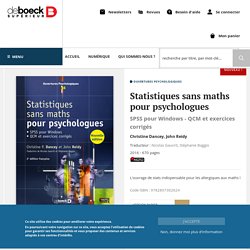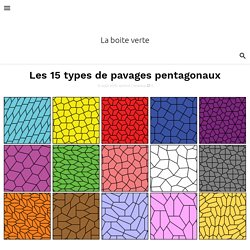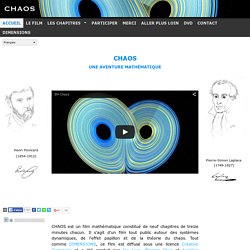

Mandelbrot et Feigenbaum vidéo. Statistiques sans maths pour psychologues. Suivant un plan très efficace, Statistiques sans maths pour psychologues est conçu pour exposer de manière claire et didactique les concepts et techniques clés en statistiques, sans faire appel à des connaissances avancées en mathématiques.

Il accorde une grande place à la compréhension de l’utilisation des statistiques, des résultats et de leur interprétation, plutôt qu’à la formalisation mathématique, aussi bien pour la présentation des concepts que pourl’utilisation du logiciel SPSS. Fondamentalement tourné vers la pratique, il donne ainsi aux étudiants le bagage nécessaire pour comprendre les articles scientifiques, mais aussi pour analyser et interpréter des données de manière autonome.Directement conçu pour les étudiants, cet ouvrage très pédagogique propose de nombreux exercices et activités qui leur permettent de mettre en pratique les notions abordées et de manipuler le logiciel SPSS par eux-mêmes. Why Zero Is So Ridiculously Important. Zero is a strange beast.

It took until the 7th century for it to be explicitly recognized as a number in its own right, when the ancient Indians developed a numerical system that expressed zero with its own symbol. Since the development of this number system, which we still use today, zero has been instrumental in our exploration of mathematics. The human use of numbers sprang from the practical need to count things, but at the time zero was only used to denote an absence of value. In this light, could it even be considered a number? As human thought progressed, however, and mathematics became more of an abstract process to unravel reality, zero started to prove itself as a very useful tool.
This animated video from The Royal Institution, narrated by mathematician Hannah Fry, tells the story of this winding history, from its role in ancient civilizations to our current world of computer technology, and explains how zero became a mathematical hero. Les 15 types de pavages pentagonaux. En géométrie les pavages les plus courants sont une façon de remplir un plan de formes géométriques identiques sans laisser d’espace vide.

Pour les triangles et les parallélogrammes c’est facile puisque ça marche avec tous, par contre ça se complique pour les pentagones. On connaissait juste 9 types de pavages pentagonaux qui respectaient ces conditions en 1975, 4 de plus en 1976, il fallut attendre 1985 pour trouver le 14ème. On se doutait que la liste n’était pas complète mais les suivants restaient un mystère jusqu’au mois dernier où des scientifiques en on trouvé un quinzième ( en bas à droite ).
21 GIFs That Explain Mathematical Concepts. “Let's face it; by and large math is not easy, but that's what makes it so rewarding when you conquer a problem, and reach new heights of understanding.”

Danica McKellar As we usher in the start of a new school year, it’s time to hit the ground running in your classes! Math can be pretty tough, but since it is the language in which scientists interpret the Universe, there’s really no getting around learning it. Check out these gifs that will help you visualize some tricky aspects of math, so you can dominate your exams this year. Ellipse: Via: giphy Solving Pascal triangles: Via: Hersfold via Wikimedia Commons Use FOIL to easily multiply binomials: Via: mathcaptain Here’s how you solve logarithms: Via: imgur Use this trick so you don’t get mixed up when doing matrix transpositions: Via: Wikimedia Commons What the Pythagorean Theorem is really trying to show you: Via: giphy Exterior angles of polygons will ALWAYS add up to 360 degrees: Via: math.stackexchange Via: imgur Via: Wikimedia Commons Via: reddit. Benoit Mandelbrot - Hunting the Hidden Dimension Nova (2008) CHAOS. CHAOS est un film mathématique constitué de neuf chapitres de treize minutes chacun.

Il s'agit d'un film tout public autour des systèmes dynamiques, de l'effet papillon et de la théorie du chaos. Tout comme DIMENSIONS, ce film est diffusé sous une licence Creative Commons et a été produit par Jos Leys, Étienne Ghys et Aurélien Alvarez. CHAOS est disponible dans un large choix de langues et de sous-titres. Phics.pdf. Mathématiques. Benoit Mandelbrot - Hunting the Hidden Dimension Nova (2008)